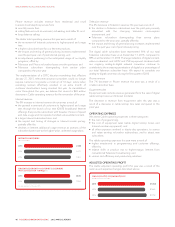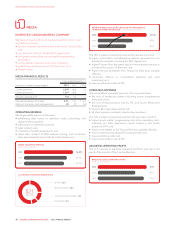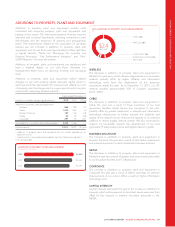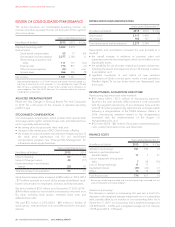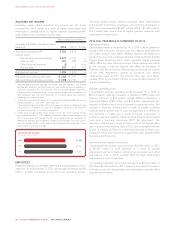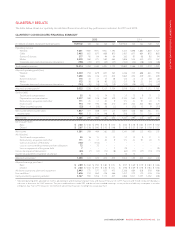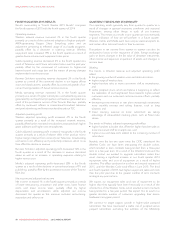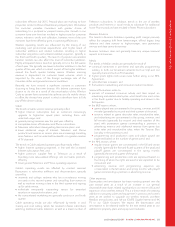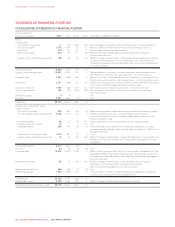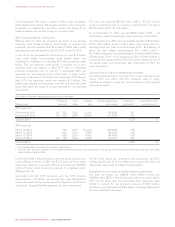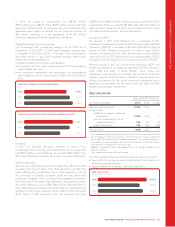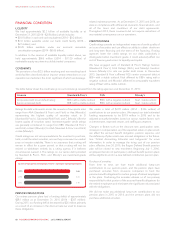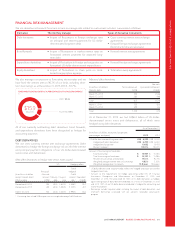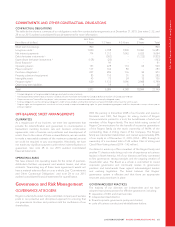Rogers 2015 Annual Report Download - page 57
Download and view the complete annual report
Please find page 57 of the 2015 Rogers annual report below. You can navigate through the pages in the report by either clicking on the pages listed below, or by using the keyword search tool below to find specific information within the annual report.
MANAGEMENT’S DISCUSSION AND ANALYSIS
subscribers effective July 2015. Prepaid plans are evolving to have
properties similar to those of traditional postpaid plans. We believe
this evolution provides Canadians with greater choice of
subscribing to a postpaid or prepaid service plan. Growth in our
customer base over time has resulted in higher costs for customer
service, retention, credit, and collection; however, most of the cost
increases have been offset by gains in operating efficiencies.
Wireless operating results are influenced by the timing of our
marketing and promotional expenditures and higher levels of
subscriber additions and related subsidies, resulting in higher
subscriber acquisition and activation-related expenses, typically in
the third and fourth quarters. The launch of popular new wireless
handset models can also affect the level of subscriber additions.
Highly-anticipated device launches typically occur in the fall season
of each year. We typically see lower subscriber additions in the first
quarter of the year, which is a direct impact of the higher additions
around the fourth quarter holiday season. Wireless roaming
revenue is dependent on customer travel volumes, which is
impacted by the value of the foreign exchange rate of the
Canadian dollar and general economic conditions.
Recently, we have noticed a significant increase in customers
choosing to bring their own devices. We believe customers have
chosen to do this as a result of the introduction of the Wireless
Code as carriers have increased the upfront cost of a mobile device
to offset the shorter time period in which subscribers have to fully
payoffthedevicesubsidy.
Cable
The trends in Cable services revenue primarily reflect:
• higher Internet subscription fees as customers increasingly
upgrade to higher-tier speed plans, including those with
unlimited usage; and
• general pricing increases over the past year; offset by
• competitive losses of Television and Phone subscribers;
• Television subscribers downgrading their service plans; and
• lower additional usage of Internet, Television, and Phone
products and services as service plans are increasingly bundling
more features, such as unlimited bandwidth or a greater number
of TV channels.
The trends in Cable adjusted operating profit primarily reflect:
• higher Internet operating expenses, in line with the increased
Internet subscription fees; and
• higher premium supplier fees in Television as a result of
bundling more value-added offerings into our Cable products;
offset by
• lower general Television and Phone operating expenses.
Cable’s operating results are affected by modest seasonal
fluctuations in subscriber additions and disconnections, typically
caused by:
• university and college students who live in residences moving
out early in the second quarter and cancelling their service as
well as students moving in late in the third quarter and signing
up for cable service;
• individuals temporarily suspending service for extended
vacations or seasonal relocations; and
• the concentrated marketing we generally conduct in our fourth
quarter.
Cable operating results are also influenced by trends in cord
shaving and cord cutting, which has resulted in fewer subscribers
watching traditional cable television, as well as a lower number of
Television subscribers. In addition, trends in the use of wireless
products and Internet or social media to substitute for traditional
home Phone products have resulted in fewer Phone subscribers.
Business Solutions
The trends in Business Solutions operating profit margin primarily
reflect the ongoing shift from lower-margin, off-net legacy long
distance and data services to higher-margin, next generation
services and data centre businesses.
Business Solutions does not generally have any unique seasonal
aspects to its business.
Media
The trends in Media’s results are generally the result of:
• continual investment in primetime and specialty programming
relating to both our broadcast networks (such as City) and our
specialty channels (such as FX (Canada));
• higher sports rights costs as we move further along in our NHL
Agreement;
• subscriber rate increases; and
• fluctuations in advertising and consumer market conditions.
Seasonal fluctuations relate to:
• periods of increased consumer activity and their impact on
advertising and related retail cycles, which tend to be most active
in the fourth quarter due to holiday spending and slower in the
first quarter;
• the MLB season, where:
• games played are concentrated in the spring, summer, and fall
months (generally the second and third quarters of the year);
• revenue related to game day ticket sales, merchandise sales,
and advertising are concentrated in the spring, summer, and
fall months (generally the second and third quarters of the
year), with postseason games commanding a premium in
advertising revenue and additional revenue from game day
ticket sales and merchandise sales, when the Toronto Blue
Jays play in the postseason; and
• programming and production costs and player payroll are
expensed based on the number of games aired; and
• the NHL season, where:
• regular season games are concentrated in the fall and winter
months (generally the first and fourth quarters of the year) and
playoff games are concentrated in the spring months
(generally the second quarter of the year);
• programming and production costs are expensed based on
the timing of when the rights are aired or are expected to be
consumed; and
• advertising revenue and programming expenses are
concentrated in the fall, winter, and spring months, with playoff
games commanding a premium in advertising revenue.
Other expenses
Depreciation and amortization has been trending upward over the
past several years as a result of an increase in our general
depreciable asset base, related significantly to our recent rollout and
expansion of our wireless network. This is a direct result of increasing
additions to property, plant and equipment in previous and current
yearsasweworkedtoupgradeourwirelessnetwork,purchase
NextBox set-top boxes, and roll out IGNITE Gigabit Internet and 4K
TV to our Cable footprint. We expect the depreciation and
amortization to be relatively stable for the next several years as our
additions to property, plant and equipment moderate.
2015 ANNUAL REPORT ROGERS COMMUNICATIONS INC. 55



